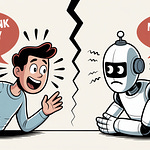"If AI does your homework, then what's the point?"
We had dinner with our college-aged son last night, who is graduating in less than two weeks. As we often do, we asked him, "How are classes going, son?" He looked thoughtful. "Good. Just need to finish up three more essays."
I paused, mid-bite. "What's to stop students from using AI on their essays?" My son and I love discussing AI together. Just last night, we were comparing GPT-4 and Claude. He answered immediately, "Our professors say we can use AI if we want, but we are only cheating ourselves. AI is so good at this point that they would not be able to tell if you do. But, if you did, what is the point?"
I thought about his words for the rest of the evening.
Where does AI fit into education now?
Academic Integrity and Ethical Use of AI
The ease of using AI to complete assignments raises significant concerns about academic integrity. Some institutions have adopted policies to regulate AI use, while others are still developing strategies. At my son's university, professors differed in how they wished students to use AI. Some encouraged it as they knew this was a skill students would need for the workforce. But, there were always guidelines as to how it should be used. I attended an "Ethics in AI" lecture offered by the university during parent weekend. Part of the presentation was done by a professor, and part of it was done by a student. They took turns explaining how AI should be integrated into the classroom.
Professor Ethan Mollick, a noted expert in this area, frequently discusses this issue in his blog and covers it extensively in his new book, "Co-Intelligence." Mollick argues that while AI can democratize access to good writing, it also presents risks if not used responsibly. He emphasizes that students should use AI to enhance their learning rather than replace their effort. Mollick's insights highlight the importance of using AI as a supportive tool to develop critical thinking and creativity, rather than a shortcut to complete assignments.
Educators emphasize that over-reliance on AI could undermine students' development of critical thinking and creative skills. While AI can assist in generating content, it is essential for students to engage deeply with the material, curate AI outputs, and use these tools as aids rather than crutches. This balanced approach ensures that students gain the full educational benefits while maintaining academic integrity.

Critical Thinking and Creativity
AI presents both opportunities and challenges in fostering critical thinking and creativity. By automating routine tasks, AI allows students and educators to allocate more time to deeply engage with complex material. AI can be utilized to create dynamic learning environments where students actively interact with the material. For example, AI-driven platforms can simulate classroom discussions, provide instant feedback on assignments, and adapt content to individual learning styles. These capabilities encourage students to think critically and creatively, promoting deeper understanding and innovative problem-solving skills.
Innovative Teaching Methods
AI is revolutionizing teaching methods by fostering more interactive and personalized learning experiences. Educators are leveraging AI to enhance traditional practices and create new opportunities for student engagement. For instance, AI can analyze student data to provide tailored feedback, identify learning gaps, and suggest resources that align with individual needs.
Moreover, AI tools can support diverse learning styles by offering multimedia content, adaptive learning paths, and interactive simulations. These innovations not only make learning more accessible but also encourage active participation and critical thinking. By integrating AI into the curriculum, educators can create dynamic, responsive learning environments that better prepare students for the future.
Furthermore, AI can improve accessibility for students with disabilities by providing assistive technologies and multilingual support, creating a more inclusive educational environment.
Final Thoughts
As we navigate the integration of AI in education, it is essential to balance innovation with integrity. By developing policies for ethical AI use, fostering critical thinking and creativity, and exploring innovative teaching methods, we can harness the full potential of AI while maintaining the integrity of the educational experience.
My son's insightful response underscores the importance of using AI as a tool for learning rather than a shortcut. As educators and students alike adapt to this evolving landscape, the goal should always be to enhance understanding, foster creativity, and uphold the principles of academic integrity.
"I'm going to sit outside and work on my essays tomorrow," my son said at the end of our conversation. "If I run out of inspiration, my other favorite place to write is the Maker Lab. The sound of the 3D printers helps me think."
Critical thinking is alive and well as long as students understand there is a reason for the assignment. Teaching critical reasoning is a prime role of educational institutions. When students realize the purpose behind their homework, they are more likely to engage deeply and develop the skills needed to succeed both academically and in life.
Additional Resources for Inquisitive Minds:
The Future of Education in a World of AI. Ethan Mollick. One Useful Thing.
How AI Is Changing Education for Better or Worse. Diana Wolf Torres. Deep Learning Daily.
Envisioning Tomorrow: The Future of AI in Classrooms. Diana Wolf Torres. Deep Learning Daily.
#aiineducation #aiethics #deeplearningwiththewolf
















Share this post